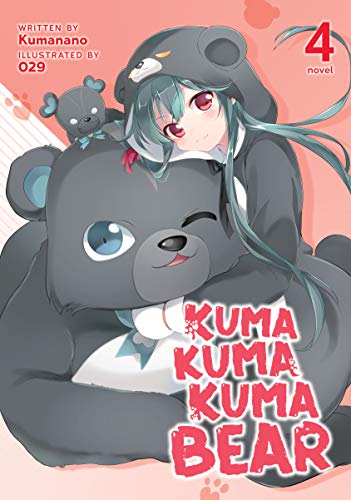By Kumanano and 029. Released in Japan by PASH! Books. Released in North America by Seven Seas. Translated by Jan Cash & Vincent Castaneda.
Apologies for the slang here, but as I was reading this volume of Kuma Bear, I kept thinking about recent discussion of ‘gap moe’. Sure, I’m certain there are some people who read this series for the cute girls doing cute things, or for Yuna being stupidly overpowered, or even for the food descriptions. But I think the best reason to read it is for those moments where Yuna’s deadpan, staid character is forced to actually react to things – usually embarrassment, but not always. As I’ve said before, her desire to not take credit for anything she does is starting to feel like a complex, and people are beginning to notice – even kids like Fina. That’s not to say it works all the time, as her Bear Tunnel shows us. What’s more, Yuna gets as uncomfortable with the rough, spiky parts of this world as the reader does, and would much rather try not to think about the whole thing – though she does help out in the end. She hopes by thinking of herself as dull and normal, it will rewrite reality.
Most of this book is devoted to the seaport Mileela, and the aftermath of Yuna wiping out the bandits and boiling the kraken. Returning to normal is not something that can happen as fast as the anime implied it. The town is still pretty much devastated by the last few months, the foreign ships don’t know that they can start sailing there again, and while they would like to ally themselves with Cliff’s city Crimonia, but there’s still that huge mountain in the way. Fortunately, they have Yuna, who once met common sense in passing but promptly went somewhere else. Now there’s a huge tunnel connecting the two areas. Problem solved! Well, except it needs lights. And air. And monster cleanouts. And guards. Yuna may be an overpowered bear girl, but cleaning up after her remains a very exhausting job.
Not sure this counts as ‘gap moe’, but the scene that intrigued me the most, as I implied above, is when Yuna is asking the innkeeper’s daughter Anz to run her new shop. Anz asks if she can have some help in the form of the young women Yuna rescued from the bandits last book – that is to say, the ones whose families were killed and were raped by said bandits. Unsurprisingly, they find still living in the town incredibly uncomfortable. It’s these sort of scenes that you really would not see in this cutesy bear and girls sort of book – indeed, the anime tries to gloss over this – and the fact that it comes up over and over again, ever since Book 1 (where, you’ll recall, Yuna in Japan paid her parents off to go away and leave her alone) just won’t let me go. That said… the majority of this book *is* Bear does OP things” “Bear hangs out with cute kids”, “Bear comments sarcastically on events”, etc.
We get setup for what I assume is the next book near the end, where Yuna is asked to guard a bunch of pampered royals as they journey to the forest to hunt some low-level monsters. It is implied that Yuna’s sharp tongue may be more devastating than any monsters, but we shall see. Till then, this remains a cute, if sometimes more disturbing than expected, book. (Oh yes, and LOL at Yuna accidentally walking around in the white bear outfit one day, which she compares to walking outside in her pajamas.)



